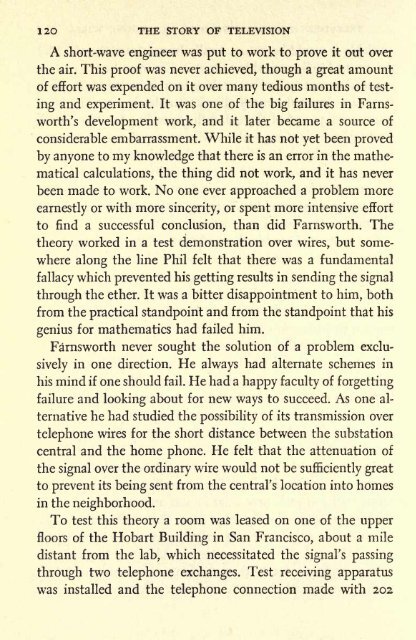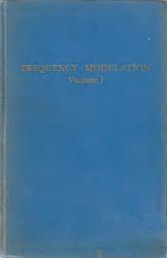the life of Philo T Farnsworth - Early Television Foundation
the life of Philo T Farnsworth - Early Television Foundation
the life of Philo T Farnsworth - Early Television Foundation
Create successful ePaper yourself
Turn your PDF publications into a flip-book with our unique Google optimized e-Paper software.
12O<br />
THE STORY OF TELEVISION<br />
A short-wave engineer was put to work to prove<br />
it out over<br />
<strong>the</strong> air. This pro<strong>of</strong> was never achieved, though a great amount<br />
<strong>of</strong> effort was expended on it over many tedious months <strong>of</strong> testing<br />
and experiment. It was one <strong>of</strong> <strong>the</strong> big failures in <strong>Farnsworth</strong>'s<br />
development work, and it later became a source <strong>of</strong><br />
considerable embarrassment. While it has not yet been proved<br />
by anyone to my knowledge that <strong>the</strong>re is an error in <strong>the</strong> ma<strong>the</strong>matical<br />
calculations, <strong>the</strong> thing did not work, and it has never<br />
been made to work. No one ever approached a problem more<br />
earnestly or with more sincerity, or spent more intensive effort<br />
to find a successful conclusion, than did <strong>Farnsworth</strong>. The<br />
<strong>the</strong>ory worked in a test demonstration over wires, but somewhere<br />
along <strong>the</strong> line Phil felt that <strong>the</strong>re was a fundamental<br />
fallacy which prevented his getting results in sending <strong>the</strong> signal<br />
through <strong>the</strong> e<strong>the</strong>r. It was a bitter disappointment to him, both<br />
from <strong>the</strong> practical standpoint and from <strong>the</strong> standpoint that his<br />
genius for ma<strong>the</strong>matics had failed him.<br />
<strong>Farnsworth</strong> never sought <strong>the</strong> solution <strong>of</strong> a problem exclusively<br />
in one direction. He always<br />
had alternate schemes in<br />
his mind if one should fail. He had a happy faculty <strong>of</strong> forgetting<br />
failure and looking about for new ways to succeed. As one alternative<br />
he had studied <strong>the</strong> possibility<br />
<strong>of</strong> its transmission over<br />
telephone wires for <strong>the</strong> short distance between <strong>the</strong> substation<br />
central and <strong>the</strong> home phone. He felt that <strong>the</strong> attenuation <strong>of</strong><br />
<strong>the</strong> signal over <strong>the</strong> ordinary wire would not be sufficiently great<br />
to prevent its being sent from <strong>the</strong> central's location into homes<br />
in <strong>the</strong> neighborhood.<br />
To test this <strong>the</strong>ory a room was leased on one <strong>of</strong> <strong>the</strong> upper<br />
floors <strong>of</strong> <strong>the</strong> Hobart Building in San Francisco, about a mile<br />
distant from <strong>the</strong> lab, which necessitated <strong>the</strong> signal's passing<br />
through two telephone exchanges. Test receiving apparatus<br />
was installed and <strong>the</strong> telephone connection made with 202











